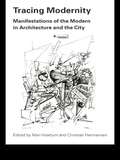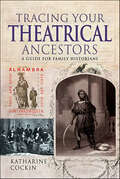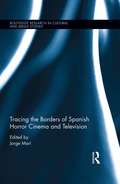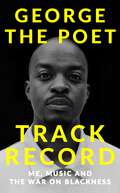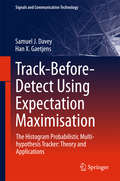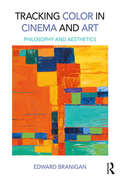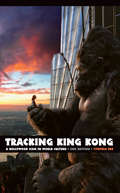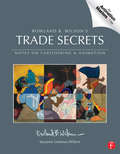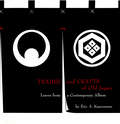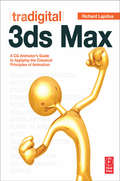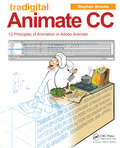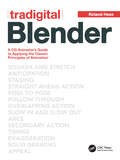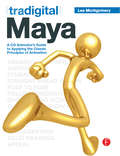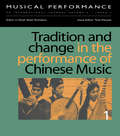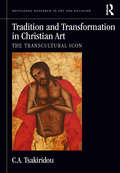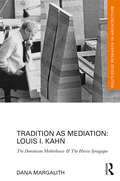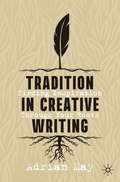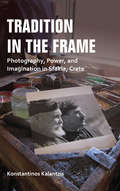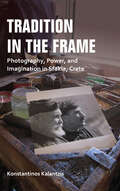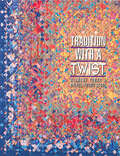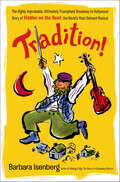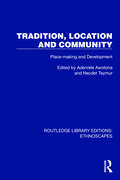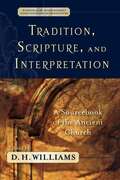- Table View
- List View
Tracing Modernity: Manifestations of the Modern in Architecture and the City
by Mari Hvattum Christian HermansenFirst published in 2004. Routledge is an imprint of Taylor & Francis, an informa company.
Tracing Your Theatrical Ancestors: A Guide for Family Historians
by Katharine M. CockinAn essential source of reference for researchers trying to uncover the theatrical experience of one of their forebears. How can you find out about the lives of ancestors who were involved in the world of theater: on stage and on film, in the music halls and traveling shows, in the circus and in all sorts of other forms of public performance? Katharine Cockin’s handbook provides a fascinating introduction for readers searching for information about ancestors who had clearly defined roles in the world of the theater and performance as well as those who left only a few tantalizing clues behind. The wider history of public performance is outlined, from its earliest origins in church rituals and mystery plays through periods of censorship driven by campaigns on moral and religious grounds up to the modern world of stage and screen. Case studies, which are a special feature of the book, demonstrate how the relevant records and be identified and interpreted, and they prove how much revealing information they contain. Information on relevant archives, books, museums and websites make this an essential guide for anyone who is keen to explore the subject.
Tracing the Borders of Spanish Horror Cinema and Television (Routledge Research in Cultural and Media Studies)
by Jorge MaríThis critical anthology sets out to explore the boom that horror cinema and TV productions have experienced in Spain in the past two decades. It uses a range of critical and theoretical perspectives to examine a broad variety of films and filmmakers, such as works by Alejandro Amenábar, Álex de la Iglesia, Pedro Almodóvar, Guillermo del Toro, Juan Antonio Bayona, and Jaume Balagueró and Paco Plaza. The volume revolves around a set of fundamental questions: What are the causes for this new Spanish horror-mania? What cultural anxieties and desires, ideological motives and practical interests may be behind such boom? Is there anything specifically "Spanish" about the Spanish horror film and TV productions, any distinctive traits different from Hollywood and other European models that may be associated to the particular political, social, economic or cultural circumstances of contemporary Spain?
Track Record: THE REVOLUTIONARY MEMOIR FROM THE UK'S MOST CREATIVE VOICE
by George the PoetThe ground-breaking memoir by acclaimed rapper and podcast host, George the PoetBorn to Ugandan parents on the St Raphael's Estate in Neasden, north-west London, George has always been an ambitious storyteller. Influenced by his hometown, George started MCing , and eventually found his voice in poetry and with it an avenue for change.Track Record: Me, Music, and the War on Blackness sheds light on George's upbringing and artistic career. He looks back at his education, his time at university, and his beginnings as a musician. We are given an insight into the forces that have shaped him and the stories he chooses to tell. As with George's other work, Track Record goes beyond the traditional memoir and takes the reader on a journey throughout history. George dives deep into the complexities of the economy and interrogates the legacy of colonialism. He reflects on music and its power as a political force - how it can be a catalyst for social power and economic change. By weaving a story that is both personal and political, George delivers an incredibly powerful and unique perspective on the world around us. Honest, thought-provoking and lyrical, Track Record is a fascinating insight by an inimitable storyteller.
Track Record: THE REVOLUTIONARY MEMOIR FROM THE UK'S MOST CREATIVE VOICE
by George the Poet**The ground-breaking memoir by acclaimed rapper and podcast host, George the Poet**__________'When Grime became the soundtrack to our lives, it gave a voice to the hustle. We were all looking for money, but it was deeper than that; we were looking for a future.'George the Poet knows better than anybody the importance of understanding your surroundings. Born to Ugandan parents on the St Raphael's Estate in Neasden, north-west London, George Mpanga has always been aware of his community. It was both his teacher and his inspiration - giving him the language, the experiences, and the skills to become the person he is today.In Track Record, George unveils the power dynamics that shape our world, shedding light on the forces that restrict Black creativity and put limits on Black excellence. By interrogating the history of colonialism and exploring capitalism's racist legacy, George offers a fresh perspective on the world around us.Delving into the music scene and iconic films from his childhood, as well as crucial political and economic moments in history, this book provides the backstory of where we are today.Honest, thought-provoking, and passionate, Track Record is a ground-breaking memoir by one of the UK's most unique voices.__________(P)2023 Hodder & Stoughton Limited
Track-Before-Detect Using Expectation Maximisation
by Samuel J. Davey Han X. GaetjensThis book offers a detailed description of the histogram probabilistic multi-hypothesis tracker (H-PMHT), providing an accessible and intuitive introduction to the mathematical mechanics of H-PMHT as well as a definitive reference source for the existing literature on the method. Beginning with basic concepts, the authors then move on to address extensions of the method to a broad class of tracking problems. The latter chapters present applications using recorded data from experimental radar, sonar and video sensor systems. The book is supplemented with software that both furthers readers’ understanding and acts as a toolkit for those who wish to apply the methods to their own problems.
Tracking Color in Cinema and Art: Philosophy and Aesthetics
by Edward BraniganColor is one of cinema’s most alluring formal systems, building on a range of artistic traditions that orchestrate visual cues to tell stories, stage ideas, and elicit feelings. But what if color is not—or not only—a formal system, but instead a linguistic effect, emerging from the slipstream of our talk and embodiment in a world? This book develops a compelling framework from which to understand the mobility of color in art and mind, where color impressions are seen through, and even governed by, patterns of ordinary language use, schemata, memories, and narrative. Edward Branigan draws on the work of Ludwig Wittgenstein and other philosophers who struggle valiantly with problems of color aesthetics, contemporary theories of film and narrative, and art-historical models of analysis. Examples of a variety of media, from American pop art to contemporary European cinema, illustrate a theory based on a spectator’s present-time tracking of temporal patterns that are firmly entwined with language use and social intelligence.
Tracking King Kong: A Hollywood Icon in World Culture
by Cynthia ErbStudies the cultural impact and audience reception of King Kong from the 1933 release of the original film until today.
Trade Secrets: Rowland B. Wilson’s Notes on Design for Cartooning and Animation
by Rowland B. WilsonAnimation doesn't come with instructions; Rowland B. Wilson demanded guidelines. Trade Secrets offers a never before published peek into the personal journals of Rowland B. Wilson (1930-2005), a legend in the world of Cartooning, Advertising, Illustration and Animation. Trade Secrets is a compendium of tips, tricks, philosophies and techniques garnered over a lifetime of professional animation and artistry. Study one-on-one with a mentor whose Walt Disney film credits include The Little Mermaid, Tarzan, Atlantis and Treasure Planet. These writings represent the quintessential refresher for fine artists and animation professionals, and are vital tutorials for students who are now poised to be part of another new generation in the art form. Have a seat and let an amiable, respected mentor reveal his keys to success. Develop your professional creative toolset with a focus on foundational animation techniques. Inspiration in your pocket; Trade Secrets includes a digital pocket guide, filled with charts and diagrams as well as helpful tools and tips.
Trades and Crafts of Old Japan
by Eric KaemmererThis very rare series of Japanese paintings depicts everyday artisans in feudal Japan. Extensive commentary provides insight into the historical and cultural context of the scenes.More than three centuries ago, not long after Japan had entered the period of seclusion decreed by her Tokugawa rulers, an unknown artist, or perhaps a group of artists, painted a series of pictures for an album portraying contemporary trades and crafts. In creating the scenes that compose this rare relic from Tokugawa days, the anonymous painter left for later ages an invaluable record of everyday human activity in the utilitarian arts for which Japan has long been famous. It is these pictures, carefully reproduced in collotype and color and accompanied by Eric Kaemmerer's perceptive comments, that make up the present volume.These scenes of Japanese life in the early 17th century introduce a variety of craftsmen ranging from needlemaker to swordsmith, from fanmaker to carpenter, from the creator of fragile lacquer ware to the fashioner of sturdy barrels. Their trades and crafts, many of which are still carried on with little change in present-day Japan, are portrayed with painstaking attention to detail and with a decided feeling for human interest.
Trades and Crafts of Old Japan
by Eric KaemmererThis very rare series of Japanese paintings depicts everyday artisans in feudal Japan. Extensive commentary provides insight into the historical and cultural context of the scenes.More than three centuries ago, not long after Japan had entered the period of seclusion decreed by her Tokugawa rulers, an unknown artist, or perhaps a group of artists, painted a series of pictures for an album portraying contemporary trades and crafts. In creating the scenes that compose this rare relic from Tokugawa days, the anonymous painter left for later ages an invaluable record of everyday human activity in the utilitarian arts for which Japan has long been famous. It is these pictures, carefully reproduced in collotype and color and accompanied by Eric Kaemmerer's perceptive comments, that make up the present volume.These scenes of Japanese life in the early 17th century introduce a variety of craftsmen ranging from needlemaker to swordsmith, from fanmaker to carpenter, from the creator of fragile lacquer ware to the fashioner of sturdy barrels. Their trades and crafts, many of which are still carried on with little change in present-day Japan, are portrayed with painstaking attention to detail and with a decided feeling for human interest.
Tradigital 3ds Max: A CG Animator's Guide to Applying the Classical Principles of Animation
by Richard LapidusFinally bridge the gap between software-specific instruction and the world of classical animation with this easy to utilize, one-of-a-kind reference guide. With great relevance for today's digital workflows, Richard Lapidus presents innovative 3ds Max controls to the classical principles of animation like squash and stretch, anticipation, staging and more. Move beyond these fundamental techniques and explore both the emotion and technical sides of animation with character appeal and rigging. Features a robust companion website that includes demonstrations, project files, links to further resources, available at https://routledgetextbooks.com/textbooks/_author/lapidus-9780240817309/resources.php
Tradigital Animate CC: 12 Principles of Animation in Adobe Animate
by Stephen BrooksLearn how to bridge the gap between the traditional animation principles and digital software. Tradigital Flash: 12 Principles of Animation in Adobe Flash brings the essentials of traditional animation and Adobe Flash together. The early masters of animationcreated a list of 12 principles which are important for anyone who wants to create interesting and believable animation. Digital animation continues to make incredible technological advancements that give animators the capability to produce visually stunning work. New technology, however, also has a tendency to create an environment where animators are so focused on adapting to the new workflow that they tend to dismiss these fundamental animation principles… which often leads to poor and lifeless character animation. Tradigital Flash helps you focus on these principles while using the program’s wide array of features to create believable animation, consistently. Tradigital Flash joins three other Tradigital books covering Maya, Blender, and 3ds Max. This new volume in the series approaches the topic in a different way, giving readers both a practical look at the software, and providing a theoretical understanding of the genre. Learn a new principle in each chapter, the Flash tools most related to it and how to put it all together. A plethora of examples demonstrate the good methods which animators should use in Flash, how to avoid the bad ones and ways to create a workflow that works for you. An easy-to-follow approach with examples throughout the book that build on each other, showing how the principles act together. A companion website www.rubberonion.com/tradigital-animate features more examples, downloadable FLA resource files, video tutorials. Key Features Every chapter teaches you a principle, shows you the corresponding tool or tools, and shows you how to all put it together. A wide array of examples demonstrate the good, bad, and sometimes ugly procedures an animator can practice with Flash. A follow-along approach, where examples throughout the book build on each other, showing how the principles act together. A companion website features more examples, downloadable swf resource files, video tutorials.
Tradigital Blender: A CG Animator's Guide to Applying the Classical Principles of Animation
by Roland HessExpand your animation toolkit with foundational animation techniques, software expertise, professional best-practices, proven and time-tested work flows. Roland Hess, a leading Blender artist and instructor, expertly navigates you through Blender's character animation systems and controls, with a focus on each of the classical principles of animation like timing, anticipation, appeal, staging, exaggeration, squash and stretch and much more. Unique from other software titles, the Tradigital series offers a specific tool-set of practical instruction and foundational knowledge that all great animators will need to know. Expand your digital workflow to include the practical resources with the robust companion web site that include demonstrations, project files, links to further resources, available at www.tradigitalblender.com.
Tradigital Maya: A CG Animator's Guide to Applying the Classical Principles of Animation
by Lee MontgomeryExplore Disney's 12 principles of animation, while learning how to animate in Maya. You can develop your own leading digital techniques rooted to traditional workflows. From squash and stretch to timing and appeal, you will enhance your creative toolset with strong classics training and cutting edge techniques. Trusted Maya Authority, Lee Montgomery offers the only artistic guide to applying the principles of traditional animation with Maya's tools, which are used in production by the best animators and VFX artists today. Add another webpage to your favourites and expand your digital workflow to include the practical resources of the Tradigital Maya with the robust companion web site that include demonstrations, project files, links to further resources, available at www.tradigitalmaya.com.
Tradition & Change Performance (Musical Performance Ser. #Vols. 2, Pts. 2.)
by TsaoFirst published in 1998. Routledge is an imprint of Taylor & Francis, an informa company.
Tradition and Transformation in Christian Art: The Transcultural Icon (Routledge Research in Art and Religion)
by C.A. TsakiridouTradition and Transformation in Christian Art approaches tradition and transculturality in religious art from an Orthodox perspective that defines tradition as a dynamic field of exchanges and synergies between iconographic types and their variants. Relying on a new ontology of iconographic types, it explores one of the most significant ascetical and eschatological Christian images, the King of Glory (Man of Sorrows). This icon of the dead-living Christ originated in Byzantium, migrated west, and was promoted in the New World by Franciscan and Dominican missions. Themes include tensions between Byzantine and Latin spiritualities of penance and salvation, the participation of the body and gender in deification, and the theological plasticity of the Christian imaginary. Primitivist tendencies in Christian eschatology and modernism place avant-garde interest in New Mexican santos and Greek icons in tradition.
Tradition as Mediation: The Dominican Motherhouse & The Hurva Synagogue (Routledge Research in Architecture)
by Dana MargalithThis book explores Louis I. Kahn's approach to tradition as revealed in two of his important, unbuilt, projects. Focusing on Kahn's designs for the Dominican Motherhouse of St. Catherine de Ricci, Media, Pennsylvania (1965-1969), and the Hurva Synagogue, Jerusalem, Israel (1967-1974), the book challenges prevailing aesthetic and methodological assessments of Kahn's use of tradition. It reveals how an authentic and critical theoretical-historical and humanistic study of tradition nourished Kahn's designs, enabling him to mediate historical rituals, ideas and beliefs – and to develop innovative designs rooted deep in human culture while addressing real modern concerns. The book evaluates Kahn's works as a creative recreation and re-interpretation of the past, shedding light on the potential value of the meaningful consideration of tradition in modern times.
Tradition in Creative Writing: Finding Inspiration Through Your Roots
by Adrian MayTradition in Creative Writing: Finding Inspiration Through Your Roots encourages writers to rediscover sources of creativity in the everyday, showing students how to see your writing as connected to your life. Adrian May addresses a key question for many beginning writers: Where do you get your ideas from? May argues that tradition does not mean anti-progress—but is instead a kind of hidden wealth that stems from literary and historical traditions, folk and songs, self and nature, and community. By drawing on these personal and traditional wellsprings of inspiration, writers will learn to see their writing as part of a greater continuum of influences and view their work as having innate value as part of that cultural and artistic ecology. Each chapter includes accessible discussion, literary and critical readings, creative examples, and writing exercises. While the creative examples are drawn from song lyrics and poetry, the writing exercises are appropriate for all genres. Undergraduates and practitioners will benefit from this guide to finding originality in writing through exploring sources of creative inspiration.
Tradition in the Frame: Photography, Power, and Imagination in Sfakia, Crete (New Anthropologies of Europe)
by KONSTANTINOS KALANTZISSfakians on the island of Crete are known for their distinctive dress and appearance, fierce ruggedness, and devotion to traditional ways. Konstantinos Kalantzis explores how Sfakians live with the burdens and pleasures of maintaining these expectations of exoticism for themselves, for their fellow Greeks, and for tourists. Sfakian performance of masculine tradition has become even more meaningful for Greeks looking to reimagine their nation’s global standing in the wake of stringent financial regulation, and for non-Greek tourists yearning for rootedness and escape from the post-industrial north. Through fine-grained ethnography that pays special attention to photography, Tradition in the Frame explores the ambivalence of a society expected to conform to outsiders’ perception of the traditional even as it strives to enact its own vision of tradition. From the bodily reenactment of historical photographs to the unpredictable, emotionally-charged uses of postcards and commercial labels, the book unpacks the question of power and asymmetry but also uncovers other political possibilities that are nested in visual culture and experiences of tradition and the past. Kalantzis explores the crossroads of cultural performance and social imagination where the frame is both empowerment and subjection.
Tradition in the Frame: Photography, Power, and Imagination in Sfakia, Crete (New Anthropologies of Europe)
by Konstantinos KalantzisAn ethnographic study of a Greek island community’s culture in the face of modern times.Sfakians on the island of Crete are known for their distinctive dress and appearance, fierce ruggedness, and devotion to traditional ways. Konstantinos Kalantzis explores how Sfakians live with the burdens and pleasures of maintaining these expectations of exoticism for themselves, for their fellow Greeks, and for tourists. Sfakian performance of masculine tradition has become even more meaningful for Greeks looking to reimagine their nation’s global standing in the wake of stringent financial regulation, and for non-Greek tourists yearning for rootedness and escape from the post-industrial north. Through fine-grained ethnography that pays special attention to photography, Tradition in the Frame explores the ambivalence of a society expected to conform to outsiders’ perception of the traditional even as it strives to enact its own vision of tradition. From the bodily reenactment of historical photographs to the unpredictable, emotionally-charged uses of postcards and commercial labels, the book unpacks the question of power and asymmetry but also uncovers other political possibilities that are nested in visual culture and experiences of tradition and the past. Kalantzis explores the crossroads of cultural performance and social imagination where the frame is both empowerment and subjection.“In this original, beautifully written, and often moving monograph, Konstantinos Kalantzis has produced a lasting contribution to the anthropological study of contemporary Europe. Drawing on extensive fieldwork, Tradition in the Frame explores with exquisite detail a number of timely themes—the social life of photographs, conflicting tourist and local images of Crete, the performance of gender stereotypes, and the complex tension between tradition and modernity. The author’s ability to view the world through the eyes of natives and foreigners, and to deconstruct visual signs and symbols, is nothing short of stunning. For anyone interested in Europe and the Mediterranean world today, this richly documented and theoretically sophisticated volume is a must read.” —Stanley Brandes“Tradition in the Frame is a richly innovative ethnography focusing on the visual dimensions of modern Cretan mythmaking, and especially on the material reproduction and negotiation of time-honored stereotypes of warrior masculinity. Writing of a society that has largely shifted its economy from shepherding to tourism, Kalantzis incisively demonstrates how the realities of commercial exploitation and socio-political change re-frame familiar images of a society at once proudly central to the symbolism of national identity and yet also still reluctant to accept the merest hint of intrusive authority.” —Michael Herzfeld
Tradition with a Twist: Variations on Your Favorite Quilts
by Blanche Young Dalene Young-StonePut a new twist on your favorite traditional quilt designs with this guide featuring creative fabrics and modern, time-saving techniques! Legendary quilters Blanch Young and Dalene Young-Stone present a new twist on traditional quilt patterns including Boston Commons, Trip Around the World, Sunshine and Shadow, Nine Patch, Irish Chain, and more using new construction methods and composing with an exciting palette of contemporary fabrics. The authors introduce the basics of working with fabric to create strip sets to easily construct magnificent quilts. Their streamlined techniques were developed to get traditional quality results using the tools of today, such as rotary cutters and cutting mats.
Tradition!: The Highly Improbable, Ultimately Triumphant Broadway-to-Hollywood Story of Fiddler on the Roof, the World's Most Beloved Musical
by Barbara IsenbergSince it first opened on Broadway in September, 1964, Fiddler on the Roof has constantly been onstage somewhere, including four Broadway revivals, four productions on London's West End and thousands of schools, army bases and countries from Argentina to Japan. Barbara Isenberg interviewed the men and women behind the original production, the film and significant revivals--Harold Prince, Sheldon Harnick, Joseph Stein, Austin Pendleton, Joanna Merlin, Norman Jewison, Topol, Harvey Fierstein and more--to produce a lively, popular chronicle of the making of Fiddler. Published in celebration of Fiddler's 50th anniversary, Tradition! is the book for everyone who loves Fiddler and can sing along with the original cast album.
Tradition, Location and Community: Place-making and Development (Routledge Library Editions: Ethnoscapes)
by Adenrele Awotona Necdet TeymurOriginally published in 1997, as part of the Ethnoscapes: Current Challenges in the Environmental Social Sciences series, reissued now with a new series introduction, Tradition, Location and Community: Place-making and Development brings together the selected papers of seventeen architects, social scientists and planners. It offers a range of original perspectives on the relationship between the design and habituation of the built environment on the one hand and social and cultural development on the other. As an archival volume, it attempts to present a mixture of cross-disciplinary and cross-cultural perspectives. It explores the view that planning and design (the organization of the physical/built environment) which follow from the rapid transformations wrought by development must respond to, and be based on, the wants and needs of the people affected; that is, it must be in accord with their notions of environmental quality.Divided into two sections. The first section has five chapters which explore the theoretical and conceptual aspects of place-making and development. Section two consists of twelve chapters, each of which presents a case study.
Tradition, Scripture, and Interpretation: A Sourcebook of the Ancient Church (Evangelical Ressourcement)
by D. H. WilliamsTradition, Scripture, and Interpretation supplements a valuable series that helps modern church leaders return to the wisdom and insight of the early church fathers in order to apply their ancient understandings of Christian belief and practice to ministry in the twenty-first century. This sourcebook gathers key writings from the first through sixth centuries on various topics of concern to the church yesterday and today. The writings are arranged thematically, and within each theme, chronologically, revealing how the Christian tradition on a given topic developed over time. The anthology begins with a chapter examining the close relationship between Scripture and tradition in the minds of early church leaders.
